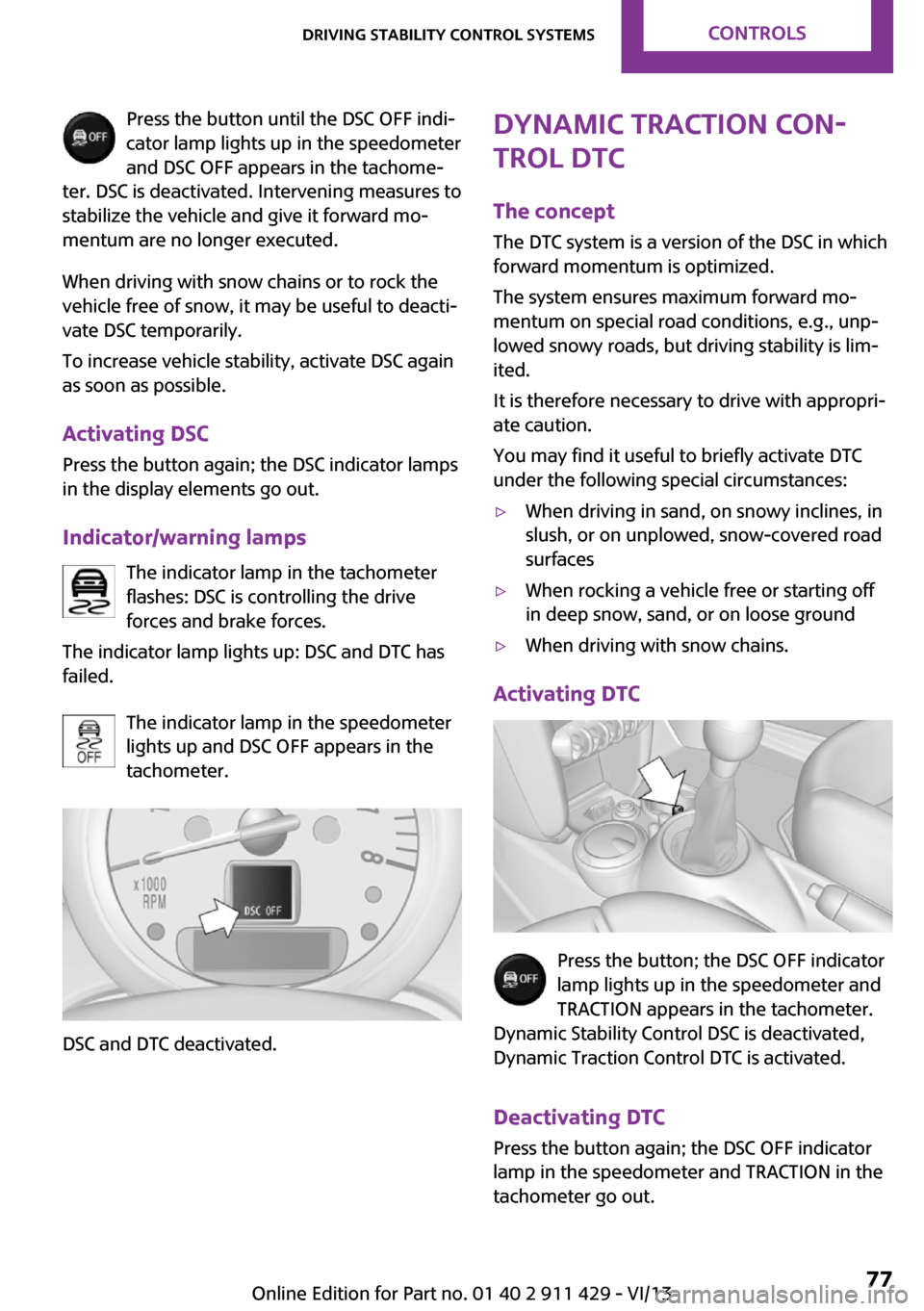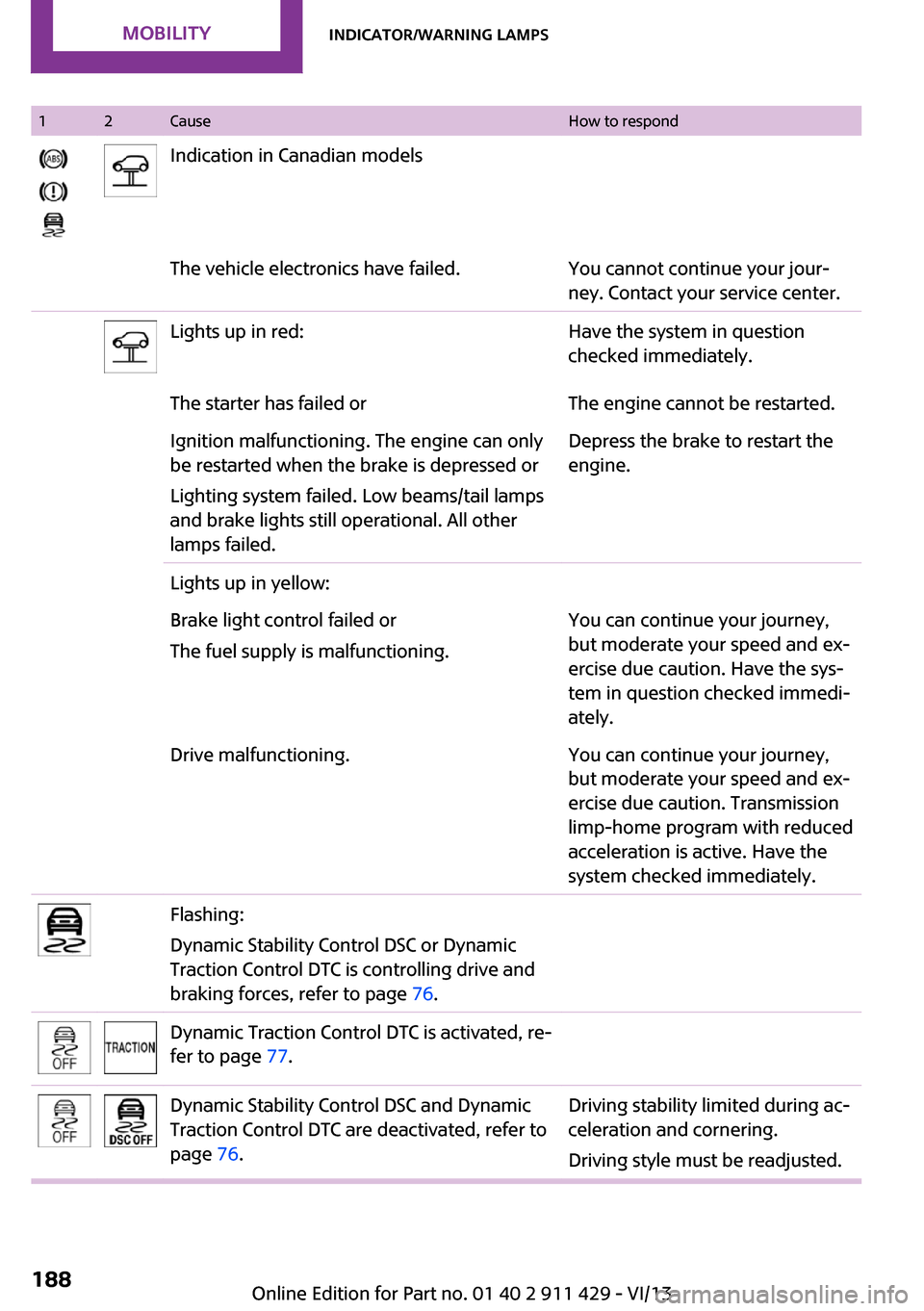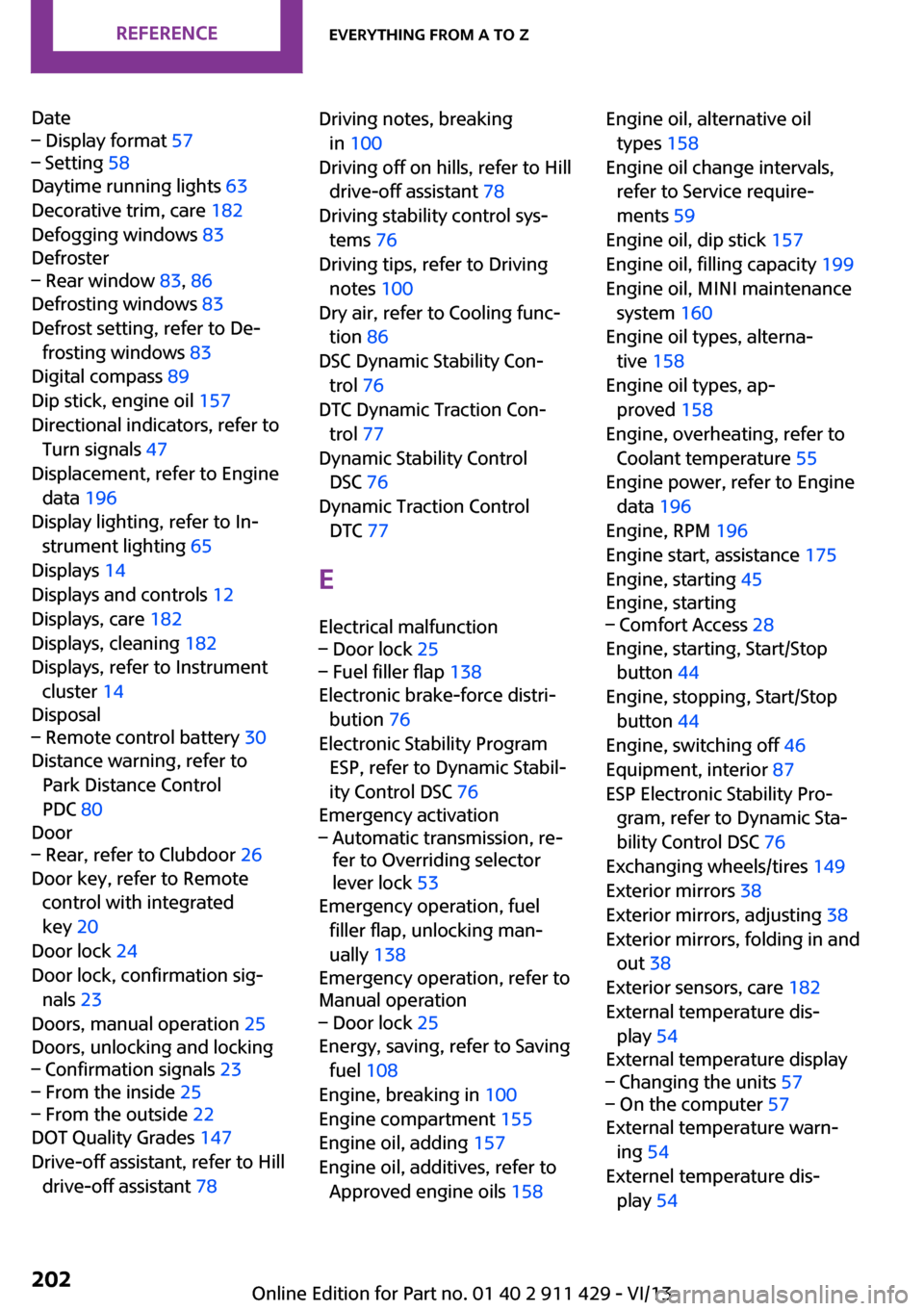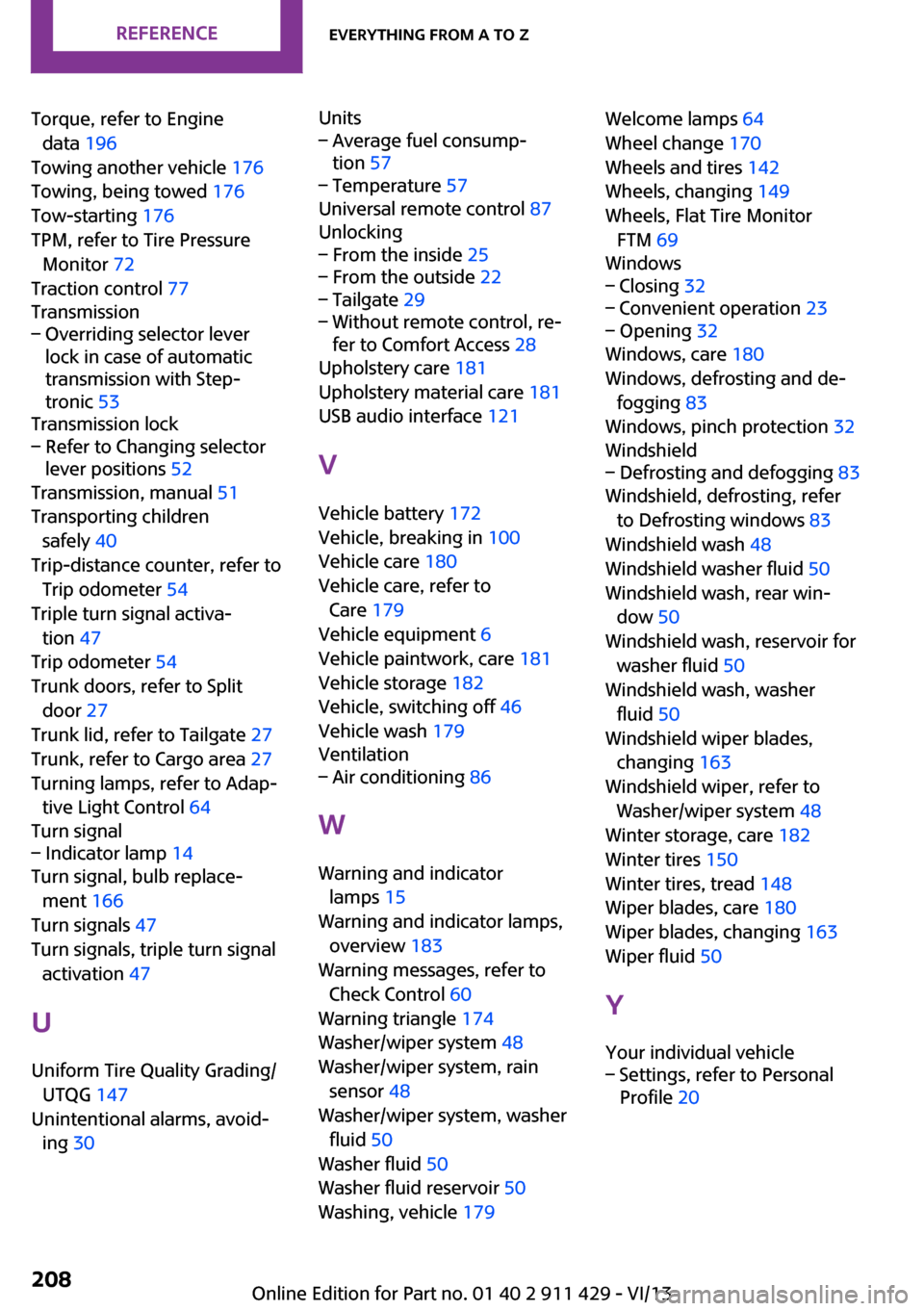traction control MINI Clubman 2014 Owner's Manual
[x] Cancel search | Manufacturer: MINI, Model Year: 2014, Model line: Clubman, Model: MINI Clubman 2014Pages: 210, PDF Size: 5.12 MB
Page 76 of 210

Driving stability control systemsVehicle equipment
This chapter describes all series equipment as
well as country-specific and special equipment
offered for this model series.Therefore, it also
describes equipment that may not be found in
your vehicle, for instance due to the selected
special equipment or the country version. This
also applies to safety-related functions and sys‐
tems.
Antilock Brake System
ABS
ABS prevents locking of the wheels duringbraking.
Steerability is maintained even during full brak‐
ing. This increases active driving safety.
ABS is operational every time you start the en‐
gine.
Electronic brake-force distribution EBVThe system controls the brake pressure in the
rear wheels to ensure stable braking behavior.
CBC Cornering Brake Control
When braking in curves or during a lane
change, driving stability and steering response
are improved further.
Brake assistant When the brakes are applied rapidly, this sys‐
tem automatically produces the maximum
braking force boost. In this way, the system
helps keep the braking distance as short as
possible. This system utilizes all of the benefits
provided by ABS.Do not reduce the pressure on the brake pedal
for the duration of full braking.
Dynamic Stability Con‐
trol DSC
The concept
DSC prevents traction loss in the driving wheels
when driving away and accelerating.
DSC also recognizes unstable vehicle condi‐
tions, such as fishtailing or nose-diving. Subject
to physical limits, DSC helps to keep the vehicle
on a steady course by reducing engine speed
and by applying brakes to the individual
wheels.
DSC is operational every time you start the en‐
gine.
Adjust your driving style to the situation
An appropriate driving style is always the
responsibility of the driver.
The laws of physics cannot be repealed, even
with DSC.
Do not reduce the additional safety margin
with a risky driving style, as otherwise there is a
risk of an accident. ◀
Deactivating DSCSeite 76ControlsDriving stability control systems76
Online Edition for Part no. 01 40 2 911 429 - VI/13
Page 77 of 210

Press the button until the DSC OFF indi‐
cator lamp lights up in the speedometer
and DSC OFF appears in the tachome‐
ter. DSC is deactivated. Intervening measures to
stabilize the vehicle and give it forward mo‐
mentum are no longer executed.
When driving with snow chains or to rock the
vehicle free of snow, it may be useful to deacti‐
vate DSC temporarily.
To increase vehicle stability, activate DSC again
as soon as possible.
Activating DSC
Press the button again; the DSC indicator lamps
in the display elements go out.
Indicator/warning lamps The indicator lamp in the tachometer
flashes: DSC is controlling the drive
forces and brake forces.
The indicator lamp lights up: DSC and DTC has
failed.
The indicator lamp in the speedometer
lights up and DSC OFF appears in the
tachometer.
DSC and DTC deactivated.
Dynamic Traction Con‐
trol DTC
The concept
The DTC system is a version of the DSC in which
forward momentum is optimized.
The system ensures maximum forward mo‐
mentum on special road conditions, e.g., unp‐
lowed snowy roads, but driving stability is lim‐
ited.
It is therefore necessary to drive with appropri‐
ate caution.
You may find it useful to briefly activate DTC
under the following special circumstances:▷When driving in sand, on snowy inclines, in
slush, or on unplowed, snow-covered road
surfaces▷When rocking a vehicle free or starting off
in deep snow, sand, or on loose ground▷When driving with snow chains.
Activating DTC
Press the button; the DSC OFF indicator
lamp lights up in the speedometer and
TRACTION appears in the tachometer.
Dynamic Stability Control DSC is deactivated,
Dynamic Traction Control DTC is activated.
Deactivating DTCPress the button again; the DSC OFF indicator
lamp in the speedometer and TRACTION in the
tachometer go out.
Seite 77Driving stability control systemsControls77
Online Edition for Part no. 01 40 2 911 429 - VI/13
Page 78 of 210

Indicator/warning lampsThe indicator lamp in the tachometer
flashes: DTC is controlling the drive
forces and brake forces.
The indicator lamp lights up: DSC and DTC has
failed.
The indicator lamp in the speedometer
lights up and TRACTION appears in the
tachometer.
DTC is activated.
Hill drive-off assistant This system supports driving away on gradients.
The handbrake is not required.
1.Hold the vehicle in place with the foot
brake.2.Release the foot brake and drive away
without delay.
Driving off without delay
After releasing the foot brake, start driv‐
ing without delay, since the drive-off assistant
will not hold the vehicle in place for more than
approx. 2 seconds and the vehicle will begin
rolling back. ◀
Sport button
When this button is pressed, the vehicle re‐
sponds in an even sportier manner.
▷The engine responds more spontaneously
to accelerator movements.▷The steering responds more directly.▷Cooper S, John Cooper Works: the engine
sounds sportier when coasting.▷For automatic transmissions: more rapid
gear changes in the Sport program.
Activating the system
Press the button; the LED in the button
lights up and SPORT is displayed briefly
in the tachometer.
Deactivating the system
▷Press the button again.▷Switch the engine off.Seite 78ControlsDriving stability control systems78
Online Edition for Part no. 01 40 2 911 429 - VI/13
Page 147 of 210

Tire sizePressure specifications in bar/PSI205/40 R 18 82 W RSC2.8/412.8/412.9/423.3/48More details on the permissible load and weights, refer to page 198.Tire identification marks
Knowledge of the labeling on the side of the tire makes it easier to identify and choose the
right tires.
Tire size Example: 225/45 R 17 91 V
225: nominal width in mm
45: aspect ratio in %
R: radial tire code
17: rim diameter in inches
91: load rating, not for ZR tires
Speed letter Q = up to 100 mph/160 km/h
T = up to 118 mph/190 km/h
H = up to 131 mph/210 km/h
V = up to 150 mph/240 km/h
W = up to 167 mph/270 km/h
Y = up to 186 mph/300 km/h
Tire Identification Number Tires with DOT codes meet the guidelines of
the U.S. Department of Transportation.
DOT code:
DOT xxxx xxx 1012
xxxx: manufacturer code for the tire brand
xxx: tire size and tire design
1012: tire age
Uniform Tire Quality GradingQuality grades can be found where applicable
on the tire sidewall between tread shoulder
and maximum section width. For example:Treadwear 200 Traction AA
Temperature A
DOT Quality Grades
Treadwear
Traction AA A B C
Temperature A B C
Conform to Federal Safety Requirements
All passenger car tires must conform to
Federal Safety Requirements in addition to
these grades. ◀
Treadwear The treadwear grade is a comparative rating
based on the wear rate of the tire when tested
under controlled conditions on a specified gov‐
ernment test course. For example, a tire graded
150 would wear one and one-half (1 1/2) times
as well on the government course as a tire
graded 100. The relative performance of tires
depends upon the actual conditions of their
use, however, and may depart significantly
from the norm due to variations in driving hab‐
its, service practices and differences in road
characteristics and climate.
Traction The traction grades, from highest to lowest, are
AA, A, B, and C.
Those grades represent the tire’s ability to stop
on wet pavement as measured under control‐
led conditions on specified government test
surfaces of asphalt and concrete. A tire marked
C may have poor traction performance.
The traction grade assigned to this tire is based
on straight-ahead braking traction tests, and
does not include acceleration, cornering, hy‐
droplaning, or peak traction characteristics.Seite 147Wheels and tiresMobility147
Online Edition for Part no. 01 40 2 911 429 - VI/13
Page 188 of 210

12CauseHow to respondIndication in Canadian modelsThe vehicle electronics have failed.You cannot continue your jour‐
ney. Contact your service center.Lights up in red:Have the system in question
checked immediately.The starter has failed orThe engine cannot be restarted.Ignition malfunctioning. The engine can only
be restarted when the brake is depressed or
Lighting system failed. Low beams/tail lamps
and brake lights still operational. All other
lamps failed.Depress the brake to restart the
engine.Lights up in yellow:Brake light control failed or
The fuel supply is malfunctioning.You can continue your journey,
but moderate your speed and ex‐
ercise due caution. Have the sys‐
tem in question checked immedi‐
ately.Drive malfunctioning.You can continue your journey,
but moderate your speed and ex‐
ercise due caution. Transmission
limp-home program with reduced
acceleration is active. Have the
system checked immediately.Flashing:
Dynamic Stability Control DSC or Dynamic
Traction Control DTC is controlling drive and
braking forces, refer to page 76.Dynamic Traction Control DTC is activated, re‐
fer to page 77.Dynamic Stability Control DSC and Dynamic
Traction Control DTC are deactivated, refer to
page 76.Driving stability limited during ac‐
celeration and cornering.
Driving style must be readjusted.Seite 188MobilityIndicator/warning lamps188
Online Edition for Part no. 01 40 2 911 429 - VI/13
Page 189 of 210

12CauseHow to respondDynamic Stability Control DSC and Dynamic
Traction Control DTC failed.Driving stability limited during ac‐
celeration and cornering.
You can continue your journey,
but moderate your speed and ex‐
ercise due caution. Have the sys‐
tem checked as soon as possible.Indication in US modelsThe driving stability control systems including
ABS and the Tire Pressure Monitor display
have failed, refer to page 76.Reduced braking and driving sta‐
bility. Drive cautiously and defen‐
sively. Avoid full brake applica‐
tion, operation on poor roads,
and use of the full throttle and
kickdown positions of the acceler‐
ator. Have the system checked
immediately.Indication in Canadian modelsThe driving stability control systems including
ABS and the Flat Tire Monitor or the Tire Pres‐
sure Monitor have failed, refer to page 76.Reduced braking and driving sta‐
bility. Drive cautiously and defen‐
sively. Avoid full brake applica‐
tion, operation on poor roads,
and use of full throttle and kick‐
down positions of the accelerator.
Have the system checked imme‐
diately.In vehicles with the Flat Tire MonitorLight up in yellow and red:A tire is deflated.Carefully bring the car to a stop.
Additional information, refer to
page 69.Seite 189Indicator/warning lampsMobility189
Online Edition for Part no. 01 40 2 911 429 - VI/13
Page 202 of 210

Date– Display format 57– Setting 58
Daytime running lights 63
Decorative trim, care 182
Defogging windows 83
Defroster
– Rear window 83, 86
Defrosting windows 83
Defrost setting, refer to De‐ frosting windows 83
Digital compass 89
Dip stick, engine oil 157
Directional indicators, refer to Turn signals 47
Displacement, refer to Engine data 196
Display lighting, refer to In‐ strument lighting 65
Displays 14
Displays and controls 12
Displays, care 182
Displays, cleaning 182
Displays, refer to Instrument cluster 14
Disposal
– Remote control battery 30
Distance warning, refer to
Park Distance Control
PDC 80
Door
– Rear, refer to Clubdoor 26
Door key, refer to Remote
control with integrated
key 20
Door lock 24
Door lock, confirmation sig‐ nals 23
Doors, manual operation 25
Doors, unlocking and locking
– Confirmation signals 23– From the inside 25– From the outside 22
DOT Quality Grades 147
Drive-off assistant, refer to Hill drive-off assistant 78
Driving notes, breaking
in 100
Driving off on hills, refer to Hill drive-off assistant 78
Driving stability control sys‐ tems 76
Driving tips, refer to Driving notes 100
Dry air, refer to Cooling func‐ tion 86
DSC Dynamic Stability Con‐ trol 76
DTC Dynamic Traction Con‐ trol 77
Dynamic Stability Control DSC 76
Dynamic Traction Control DTC 77
E Electrical malfunction– Door lock 25– Fuel filler flap 138
Electronic brake-force distri‐
bution 76
Electronic Stability Program ESP, refer to Dynamic Stabil‐
ity Control DSC 76
Emergency activation
– Automatic transmission, re‐
fer to Overriding selector
lever lock 53
Emergency operation, fuel
filler flap, unlocking man‐
ually 138
Emergency operation, refer to
Manual operation
– Door lock 25
Energy, saving, refer to Saving
fuel 108
Engine, breaking in 100
Engine compartment 155
Engine oil, adding 157
Engine oil, additives, refer to Approved engine oils 158
Engine oil, alternative oil
types 158
Engine oil change intervals, refer to Service require‐
ments 59
Engine oil, dip stick 157
Engine oil, filling capacity 199
Engine oil, MINI maintenance system 160
Engine oil types, alterna‐ tive 158
Engine oil types, ap‐ proved 158
Engine, overheating, refer to Coolant temperature 55
Engine power, refer to Engine data 196
Engine, RPM 196
Engine start, assistance 175
Engine, starting 45
Engine, starting– Comfort Access 28
Engine, starting, Start/Stop
button 44
Engine, stopping, Start/Stop button 44
Engine, switching off 46
Equipment, interior 87
ESP Electronic Stability Pro‐ gram, refer to Dynamic Sta‐
bility Control DSC 76
Exchanging wheels/tires 149
Exterior mirrors 38
Exterior mirrors, adjusting 38
Exterior mirrors, folding in and out 38
Exterior sensors, care 182
External temperature dis‐ play 54
External temperature display
– Changing the units 57– On the computer 57
External temperature warn‐
ing 54
Externel temperature dis‐ play 54
Seite 202ReferenceEverything from A to Z202
Online Edition for Part no. 01 40 2 911 429 - VI/13
Page 208 of 210

Torque, refer to Enginedata 196
Towing another vehicle 176
Towing, being towed 176
Tow-starting 176
TPM, refer to Tire Pressure Monitor 72
Traction control 77
Transmission– Overriding selector lever
lock in case of automatic
transmission with Step‐
tronic 53
Transmission lock
– Refer to Changing selector
lever positions 52
Transmission, manual 51
Transporting children safely 40
Trip-distance counter, refer to Trip odometer 54
Triple turn signal activa‐ tion 47
Trip odometer 54
Trunk doors, refer to Split door 27
Trunk lid, refer to Tailgate 27
Trunk, refer to Cargo area 27
Turning lamps, refer to Adap‐ tive Light Control 64
Turn signal
– Indicator lamp 14
Turn signal, bulb replace‐
ment 166
Turn signals 47
Turn signals, triple turn signal activation 47
U
Uniform Tire Quality Grading/ UTQG 147
Unintentional alarms, avoid‐ ing 30
Units– Average fuel consump‐
tion 57– Temperature 57
Universal remote control 87
Unlocking
– From the inside 25– From the outside 22– Tailgate 29– Without remote control, re‐
fer to Comfort Access 28
Upholstery care 181
Upholstery material care 181
USB audio interface 121
V Vehicle battery 172
Vehicle, breaking in 100
Vehicle care 180
Vehicle care, refer to Care 179
Vehicle equipment 6
Vehicle paintwork, care 181
Vehicle storage 182
Vehicle, switching off 46
Vehicle wash 179
Ventilation
– Air conditioning 86
W
Warning and indicator lamps 15
Warning and indicator lamps, overview 183
Warning messages, refer to Check Control 60
Warning triangle 174
Washer/wiper system 48
Washer/wiper system, rain sensor 48
Washer/wiper system, washer fluid 50
Washer fluid 50
Washer fluid reservoir 50
Washing, vehicle 179
Welcome lamps 64
Wheel change 170
Wheels and tires 142
Wheels, changing 149
Wheels, Flat Tire Monitor FTM 69
Windows– Closing 32– Convenient operation 23– Opening 32
Windows, care 180
Windows, defrosting and de‐ fogging 83
Windows, pinch protection 32
Windshield
– Defrosting and defogging 83
Windshield, defrosting, refer
to Defrosting windows 83
Windshield wash 48
Windshield washer fluid 50
Windshield wash, rear win‐ dow 50
Windshield wash, reservoir for
washer fluid 50
Windshield wash, washer fluid 50
Windshield wiper blades, changing 163
Windshield wiper, refer to Washer/wiper system 48
Winter storage, care 182
Winter tires 150
Winter tires, tread 148
Wiper blades, care 180
Wiper blades, changing 163
Wiper fluid 50
Y
Your individual vehicle
– Settings, refer to Personal
Profile 20Seite 208ReferenceEverything from A to Z208
Online Edition for Part no. 01 40 2 911 429 - VI/13